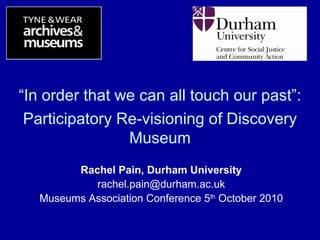¡°In order that we can all touch our past¡±: Participatory Re-visioning of Discovery Museum
- 1. ¡°In order that we can all touch our past¡±: Participatory Re-visioning of Discovery Museum Rachel Pain, Durham University rachel.pain@durham.ac.uk Museums Association Conference 5th October 2010
- 2. Participatory research Involving those conventionally ¡®researched¡¯ in some or all stages of the process, from problem definition through to action: ¨C A more collaborative, less hierarchical, less extractive approach to researching museum audiences? ¨C How far can and should we take participation in a museum context?
- 3. Research questions Research Question 1 ¡°The big vision¡± ? What are participants¡¯ ideas and wishes, needs, suggestions about the purpose of museums, how they could relate to their audience and how their audience could relate to them? Research Question 2 ¡°The Discovery visit¡± ? What do participants believe is working at Discovery and what could be improved? Research Question 3 ¡°What would help?¡± ? What reasons are there for not visiting Discovery, and what would encourage people to do so? Research Question 4: ¡°A participatory methodology¡± ? How effectively can a participatory research approach and methodology capture and integrate the views on the Museum¡¯s future from a range of visitors, non-visitors, staff and other key stakeholders?
- 4. Methodology ? Discussion groups ? Participatory diagrams ? Staff training and peer research 530 people were included from four stakeholder groups: visitors and non-visitors, external experts and specialists, city and regional funders and stakeholders, and TWAM staff and volunteers.
- 5. Some key findings ? Strong emotions about and connections with the North East (for most, a very positive identity).This shapes expectations and responses to Discovery Museum. ? And vice versa: feelings of emotional attachment to Discovery content both reflect and cement aspects of regional identity - a big part of what adults want to pass on to children during visits.
- 6. ? Consensus - no major disagreement between stakeholder groups on the purpose of museums ? But ¡®hard to reach¡¯ (socially marginalised) groups have a more negative view of life in the North East and the Museum ? They identified a number of barriers to physical, social and cultural access, which deter them from visiting ? Need to continue traditional programming, but reflect diversity of communities¡¯ histories too
- 7. Reflections on collaborating with the museum sector ? Not just a ¡®commission from a distance¡¯ or a report on the shelf - a real partnership, and real commitment ? TWAM keen to think and reflect critically ? Real enthusiasm for participatory approach, and embedding it in TWAM ? Time/finance issues ? What happens to minority voices amid a sea of others?
Editor's Notes
- #4: RQs designed based on museums priorities ¨C but to be emergent and ground up ¨C no closed tick-boxes - offer best chance of allowing new ideas in.







